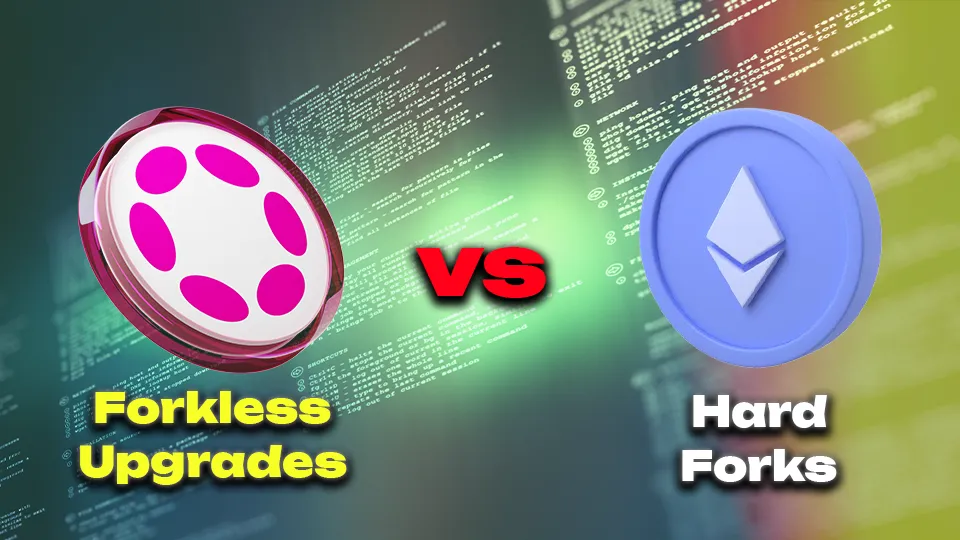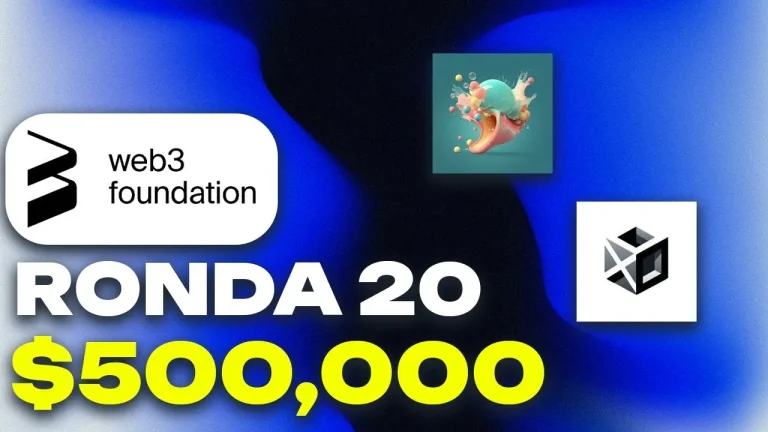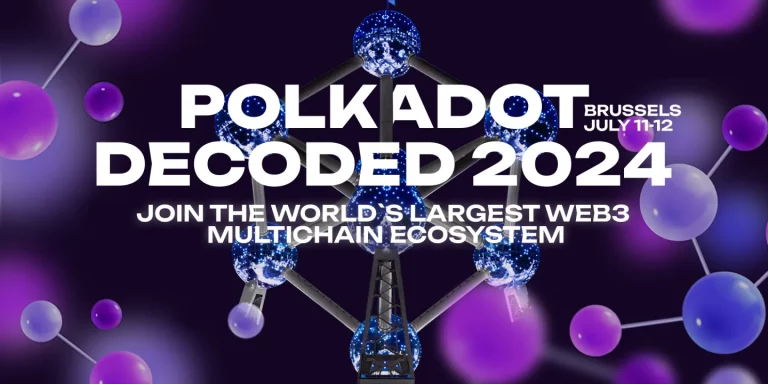In the blockchain world, how networks upgrade their protocols is crucial. Polkadot and Ethereum employ distinct approaches to protocol upgrades, reflecting their underlying architectures and governance models. This article explores the differences between Ethereum’s reliance on hard forks and Polkadot’s innovative forkless upgrade system, examining the implications, challenges, and benefits of each.
Ethereum’s Hard Forks
Ethereum, as one of the earliest and most widely adopted blockchain platforms, has traditionally relied on hard forks to implement major protocol upgrades. A hard fork is a process that introduces changes to the blockchain’s logic in a way that is not backward compatible, meaning that all nodes must upgrade their software to stay in consensus. If a portion of the network does not upgrade, it results in a split, creating two separate chains operating under different rules.
The Process and Implications of Hard Forks
Ethereum’s hard fork process typically occurs when significant changes or improvements are needed in the network, such as updates to the consensus mechanism, smart contract functionality, or security enhancements. The process requires extensive coordination among developers, node operators, validators, and the broader community to ensure a smooth transition.
However, the hard fork approach presents several challenges:
- Coordination Complexity: Coordinating a large number of nodes to upgrade their software simultaneously is logistically challenging and time-consuming. Any delay or disagreement among node operators can lead to network instability or fragmentation.
- Political Contentiousness: Hard forks often involve decisions that can be politically divisive within the community. Stakeholders may have differing views on the network’s direction, leading to disputes and, in extreme cases, network splits, as seen with the Ethereum-Ethereum Classic split following the DAO hack in 2016.
- Network Splits: One of the most significant risks of hard forks is the possibility of a network split, where a portion of the network continues operating under the old rules, creating a new, separate blockchain. This can result in confusion, security vulnerabilities, and a dilution of resources.
Polkadot’s Forkless Upgrades: A New Paradigm
In contrast to Ethereum’s hard fork approach, Polkadot employs a forkless upgrade system enabled by its Wasm-based (WebAssembly) runtime environment. This approach represents a significant shift in how blockchain networks can evolve, offering a more seamless and efficient method for protocol upgrades.
The Mechanics of Forkless Upgrades
Polkadot’s forkless upgrade system is made possible by storing the network’s runtime logic as a WebAssembly (Wasm) blob on the blockchain itself. Unlike Ethereum, where runtime logic is embedded in the node software and requires manual updates, Polkadot’s runtime is decoupled from the node software, enabling automatic upgrades.
Here’s how Polkadot’s forkless upgrades work:
- On-Chain Governance: Upgrades to Polkadot’s runtime are proposed and approved through the network’s on-chain governance system, known as Polkadot OpenGov. DOT holders can propose changes and vote on them. Proposals that gain sufficient support are put to a vote, and those that pass become referendums.
- Automatic Deployment: Once an upgrade is approved through the governance process, the new runtime is deployed on-chain and automatically enacted by all nodes at a specified block height. This allows the network to upgrade its protocol without requiring node operators to manually update their software or coordinate with each other.
- Seamless Execution: The Wasm-based runtime allows for the seamless execution of new logic across the entire network. Since the runtime is stored on-chain and interpreted by nodes, there is no need for manual intervention, reducing the risk of errors or network splits.
Advantages of Forkless Upgrades
Polkadot’s forkless upgrade process offers several key advantages over traditional hard forks:
- Efficiency: The ability to upgrade the network without requiring node operators to manually update their software makes the process more efficient and less error-prone. Upgrades can be deployed quickly without the need for extensive coordination.
- Reduced Risk of Network Splits: Because all nodes automatically follow the new runtime logic, there is no risk of a network split. This ensures that the network remains unified and secure, even as it evolves over time.
- Decentralized Governance: Polkadot’s on-chain governance system ensures that upgrades are approved through a decentralized, transparent process. Stakeholders have a direct say in the network’s evolution, with their incentives aligned with the network’s health through the locking of DOT tokens.
The Role of WebAssembly (Wasm)
WebAssembly (Wasm) plays a crucial role in enabling Polkadot’s forkless upgrades. Wasm is a binary instruction format that allows code to be executed in a virtual machine environment. It is designed to be fast, efficient, and secure, making it ideal for blockchain applications.
In Polkadot, the runtime logic is compiled to Wasm and stored on the blockchain. Nodes in the network run the Wasm code, interpreting it in real-time. This decoupling of the runtime from the node software allows for dynamic upgrades without the need for a hard fork.
Wasm’s flexibility and efficiency are key to Polkadot’s ability to implement forkless upgrades. By using Wasm, Polkadot can deploy new features, fix bugs, and improve performance without disrupting the network or requiring extensive coordination among node operators.
Blockchain Governance and Security: A Comparative Analysis
The differences between Ethereum’s hard fork approach and Polkadot’s forkless upgrades are also reflected in their governance models and security considerations.
Ethereum’s Governance Model
Ethereum’s governance model is primarily off-chain, with decisions made by developers, node operators, and other stakeholders through informal processes and community consensus. While this model has allowed Ethereum to implement significant upgrades, it also presents certain challenges:
- Centralization of Decision-Making: The reliance on core developers and influential community members for decision-making can lead to centralization of power. This can create conflicts of interest and make it difficult to achieve consensus on controversial issues.
- Political Disputes: Hard forks often involve political disputes within the community, as different stakeholders may have conflicting views on the network’s direction. This can lead to contentious debates and, in some cases, network splits.
- Security Risks: The need for manual upgrades and coordination among node operators introduces security risks. If a significant portion of the network fails to upgrade in time, it could lead to vulnerabilities or exploitation by malicious actors.
Polkadot’s On-Chain Governance
Polkadot’s on-chain governance model represents a more decentralized and transparent approach to decision-making. Key features of Polkadot’s governance system include:
- Decentralized Proposals: Any DOT holder can propose changes to the network, ensuring that the decision-making process is open to all stakeholders. Proposals that gain sufficient support are put to a vote, and those that pass become referendums.
- Skin in the Game: DOT holders who vote on proposals have their tokens locked, aligning their incentives with the network’s health. This makes it less likely for governance to make decisions that would harm the network, as that would decrease the value of the locked tokens.
- Automated Execution: Once a referendum is approved, the upgrade is automatically enacted by the network at the specified block height. This reduces the risk of human error and ensures that all nodes follow the new logic simultaneously.
Security Considerations
Polkadot’s forkless upgrades also offer security advantages over Ethereum’s hard fork approach:
- Reduced Attack Surface: By automating the upgrade process, Polkadot reduces the attack surface for potential exploits. There is no need for node operators to manually upgrade their software, reducing the risk of vulnerabilities being introduced during the upgrade process.
- Unified Network: The absence of network splits ensures that Polkadot’s network remains cohesive and secure, even as it evolves.
Conclusion
As the blockchain landscape continues to evolve, the methods by which networks upgrade their protocols are increasingly important. Ethereum’s reliance on hard forks reflects a more traditional approach, with significant coordination, political, and security challenges. While Ethereum’s ongoing transition to Proof of Stake through a series of hard forks aims to address some of these challenges, the process remains complex and fraught with risks.
On the other hand, Polkadot’s forkless upgrade system represents a novel approach to blockchain evolution. By leveraging WebAssembly and on-chain governance, Polkadot can implement seamless, efficient, and secure upgrades without the need for disruptive hard forks. This approach not only minimizes the risks of network fragmentation but also empowers the community to drive the network’s evolution in a decentralized and transparent manner.
Ultimately, both Ethereum and Polkadot offer valuable lessons in the ongoing development of blockchain technology, with each platform showcasing the potential of different governance and upgrade strategies. As these networks continue to evolve, their approaches to protocol upgrades will play a crucial role in shaping the future of decentralized technologies.








